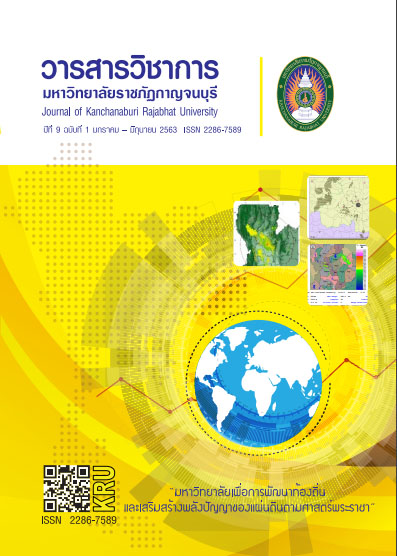ASSESSMENT OF RAINFALL THROUGH REFLECTIVITY AND RAINFALL INTENSITY RELATIONSHIP AT PHITSANULOK WEATHER RADAR STATION
Main Article Content
Abstract
This study aimed to find the relationship of the reflection of weather radar (Z) and the rain intensity (R): (Z-R relationship). The actual rain measurement was obtained from the rain gage station located on the permanent land within the weather radar radius. The study also evaluated the accuracy of precipitation estimates with the weather radar from Phitsanulok and from automatic weather stations of the Meteorological Department from 2007 to 2008. Based on the match of those radar data to determine the relationship of radar reflection and rain intensity, this principle is called Buffer Probability Technique (BPT). In this way it helped reduce the effects of winds and time deviation from their different heights during the actual measurement of weather radar and the rainfall volume on the land station by integrating the Buffer Function of Geo-informatics and matching with Probability Matching. The result was found the BPT technique was able to analyze very well the relationship between the reflectivity of the weather radar (Z) and the rainfall intensity (R): (Z-R relationship). This method was also appropriate to apply for weather forecasting and warning, especially in an urban and a large agricultural area which locates remote from meteorological stations. It benefits the planning of tourism as well.
Article Details
References
กรมอุตุนิยมวิทยา. (2521). อุตุนิยมวิทยาทั่วไป. กรุงเทพฯ : กรมอุตุนิยมวิทยา.
ชวนพิศ เงินฉลาด. (2555). การตรวจอากาศด้วยเรดาร์. สงขลา : ศูนย์อุตุนิยมวิทยาภาคใต้ฝั่งตะวันออก.
ศิริลักษณ์ ชุ่มชื่น, รัชเวช หาญชูวงศ์, และอนุสรณ์ หอมเมือง. (2541). การเปลี่ยนแปลงพารามิเตอร์ของสมการ Z-R ของกลุ่มเมฆฝนชนิดต่าง ๆ ใน. การประชุมวิชาการวิศวกรรมโยธาแห่งชาติ ครั้งที่ 14. นครราชสีมา : มหาวิทยาลัยเทคโนโลยีสุรนารี.
สุวพันธ์ นิลายน. (2539). อุตุนิยมวิทยา. กรุงเทพฯ : จุฬาลงกรณ์มหาวิทยาลัย.
Chantraket, P., Detyothin, C., & Suknarin, A. (2013). Radar reflectivity derived rain-storm characteristics over northern Thailand. EnvironmentAsia, 6(2), 24-33.
Chumchean, S., Seed, A., & Sharma, A. (2008). An operational approach for classifying storms in real-time radar rainfall estimation. Journal of Hydrology, 363(1-4), 1-17.
Doviak, R. J., & Zrnic, D. S. (1993). Doppler Radar and Weather Observations. New York: Academic Press.
Fulton, R. A., Breidenbach, J. P., Seo, D. J., Miller, D. A., & O’Bannon, T. (1998). The WSR-88D rainfall algorithm. Weather and Forecasting, 13(2), 377-395.
Marshall, J. S., & Palmer, W. M. K. (1948). The distribution of raindrops with size. Journal of Meteorology, 5(4), 165-166.
Rinehart, R. E. (2004). Radar for Meteorologists, or, You Too Can Be a Radar Meteorologist, Part III (Fourth ed.). Columbia, MO: Rinehart.
Rosenfeld, D., & Amitai, E. (1998). Comparison of WPMM versus regression for evaluating Z–R relationships. Journal of Applied Meteorology, 37(10), 1241-1249.
Sheltion, M. L. (2009). Hydroclimatology : Perspectives and Applications. Cambridge, UK: Cambridge University Press.
Woodley, W., & Herndon, A. (1970). A raingage evaluation of the Miami reflectivity-rainfall rate relation. Journal of Applied Meteorology, 9(2), 258-264.


